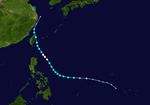1987 Pacific typhoon season
| 1987 Pacific typhoon season | |
|---|---|

Season summary map
|
|
| Seasonal boundaries | |
| First system formed | January 7, 1987 |
| Last system dissipated | December 20, 1987 |
| Strongest storm | |
| Name | Betty |
| • Maximum winds | 205 km/h (125 mph) (10-minute sustained) |
| • Lowest pressure | 890 hPa (mbar) |
| Seasonal statistics | |
| Total depressions | 26 |
| Total storms | 25 |
| Typhoons | 17 |
| Super typhoons | 6 |
| Total fatalities | > 1,438 |
| Total damage | > $402 million (1987 USD) |
| Related articles | |
| Typhoon (JMA) | |
| Category 2 typhoon (SSHWS) | |
| Duration | January 7 – January 14 |
|---|---|
| Peak intensity | 165 km/h (105 mph) (10-min) 955 hPa (mbar) |
| Tropical storm (JMA) | |
| Tropical storm (SSHWS) | |
| Duration | April 3 – April 15 |
|---|---|
| Peak intensity | 85 km/h (50 mph) (10-min) 1000 hPa (mbar) |
| Tropical storm (JMA) | |
| Tropical storm (SSHWS) | |
| Duration | June 17 – June 19 |
|---|---|
| Peak intensity | 85 km/h (50 mph) (10-min) 992 hPa (mbar) |
| Typhoon (JMA) | |
| Category 1 typhoon (SSHWS) | |
| Duration | June 26 – July 1 |
|---|---|
| Peak intensity | 120 km/h (75 mph) (10-min) 980 hPa (mbar) |
| Typhoon (JMA) | |
| Category 4 super typhoon (SSHWS) | |
| Duration | July 6 – July 16 |
|---|---|
| Peak intensity | 185 km/h (115 mph) (10-min) 915 hPa (mbar) |
| Severe tropical storm (JMA) | |
| Category 1 typhoon (SSHWS) | |
| Duration | July 15 – July 22 |
|---|---|
| Peak intensity | 110 km/h (70 mph) (10-min) 985 hPa (mbar) |
| Typhoon (JMA) | |
| Category 4 typhoon (SSHWS) | |
| Duration | July 18 – August 1 |
|---|---|
| Peak intensity | 185 km/h (115 mph) (10-min) 920 hPa (mbar) |
| Typhoon (JMA) | |
| Category 1 typhoon (SSHWS) | |
| Duration | July 21 – July 30 |
|---|---|
| Peak intensity | 120 km/h (75 mph) (10-min) 970 hPa (mbar) |
| Typhoon (JMA) | |
| Category 5 super typhoon (SSHWS) | |
| Duration | August 7 – August 17 |
|---|---|
| Peak intensity | 205 km/h (125 mph) (10-min) 890 hPa (mbar) |
The 1987 Pacific typhoon season has no official bounds; it ran year-round in 1987, but most tropical cyclones tend to form in the northwestern Pacific Ocean between May and November. These dates conventionally delimit the period of each year when most tropical cyclones form in the northwestern Pacific Ocean. Tropical storms formed in the entire west pacific basin were assigned a name by the Joint Typhoon Warning Center. Tropical depressions that enter or form in the Philippine area of responsibility are assigned a name by the Philippine Atmospheric, Geophysical and Astronomical Services Administration or PAGASA. This can often result in the same storm having two names.
A total of 25 tropical cyclones formed this year in the Western Pacific, of which 24 became tropical storms. Of the 24, 17 storms reached typhoon intensity, of which 6 reached super typhoon strength.
A total of 25 tropical cyclones formed this year in the Western Pacific, of which 24 became tropical storms. Of the 24, 17 storms reached typhoon intensity, of which 6 reached super typhoon strength.
On January 3, a small and persistent area of thunderstorms near the International Dateline was first detected. During the next few days, it slowly increased in organization and thunderstorm activity after which a small and ragged central dense overcast formed and upper level outflow improved. A Tropical Cyclone Formation Alert (TCFA) was issued late on January 7 for the disturbance. The JTWC then issued their first warning on Tropical Depression 01W during the afternoon of January 7. The next morning, on January 8, an aircraft reconnaissance mission reported tropical storm–winds and the depression was upgraded to a tropical storm and named Orchid. Orchid continued to gradually strengthen until it reached its peak intensity of 110 mph (175 km/h) on January 11 as a small typhoon. After reaching peak intensity, Orchid weakened rather quickly and by January 14, it had degenerated into an area of low pressure.
Orchid caused "extensive damage" on Ulithi Atoll but no deaths were reported. In the wake of the typhoon, the United States Federal Emergency Management Agency declared parts of the Federated States of Micronesia as a disaster area.
...
Wikipedia


















